Integrability and solutions to multi-component degenerate CH-type equations
Zhen Xiaoyan
(Department of Mathematics,Ningbo University,Ningbo315211,China)
Integrability and solutions to multi-component degenerate CH-type equations
Zhen Xiaoyan
(Department of Mathematics,Ningbo University,Ningbo315211,China)
In this paper,we propose a multi-component degenerate CH-type system with cubic nonlinearity.This system is shown to be integrable with admitting Lax pair,bi-Hamiltonian structure and recursion operator.In particular,the two-component degenerate Novikov equation is mainly concerned and its exact singular solutions with a finite number of corners are obtained.
bi-Hamiltonian structure,short-wave limit,exact singular solution,multi-component Camassa-Holm type equation
1 Introduction
The Hunter-Saxton(HS)equation

was derived by Hunter and Saxton as a model for describing propagation of orientation waves in a massive nematic liquid crystal director field[1].It can be derived as the high-frequency limit of the Camassa-Holm(CH)equation[2-3],so it can be regarded as a degenerate CH equation. Similar to the CH equation,the HS equation is also integrable[4],which admits bi-Hamiltonian structure,Lax-pair and rich symmetries[5-6].Interestingly,the HS equation can be linearizedby a reciprocal transformation[5].In the similar manner,the short-pulse equation[7]
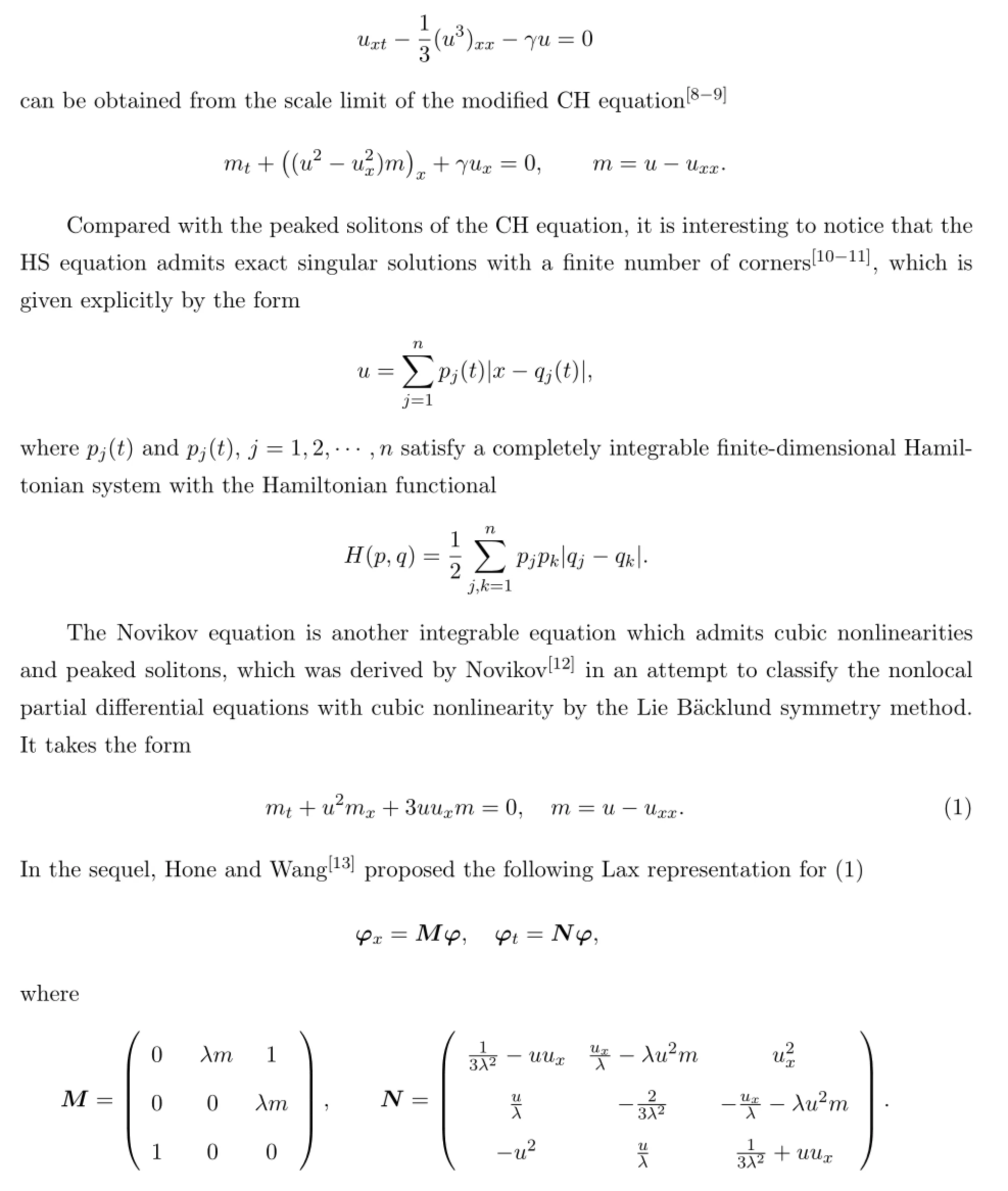
They further showed that the Novikov equation(1)is related to a negative flow in the Sawada-Kotera hierarchy.Its infinitely many conserved quantities and a bi-Hamiltonian structure are also presented.
It is of interest to find multi-component generalizations of these CH-type equations[14-19].Some of them have physical applications[20-21]and nice geometric formulations[14]. For instance,Geng and Xue[15]introduced the two-component Novikov equation:

It is also a completely integrable system,possessing Lax representation and bi-Hamiltonian structure.Moreover,they studied the special reductions of their general spectral problem.In this sense,almost all known 3×3 spectral problem for the CH-type equations are contained in this case.Recently,Popowicz[24]introduced the matrix version of the Lax representation of equation(3)in which mi=ui-uixx,ni=vi-vixx,i=1,2 are N-dimensional matrices.
In this paper,we consider the case where mi=-uixx,ni=-vixx,i=1,2 are N-dimensional vector function.Since the HS equation can be derived from high-frequency limitof the celebrated CH equation.A natural question is to extend such a study to the multicomponent systems.Analogous to the derivation of the HS equation,we construct multicomponent degenerate CH-type equation.
The structure of the paper is as follows.In Section 2,we will show that the multicomponent degenerate CH-type system is completely integrable with a Lax pair and bi-Hamiltonian structure.In Section 3,an infinite sequence of symmetries is constructed by its recursion operator.In Section 4,we consider the special reductions of our general spectral problem.
2 Construction of multi-component degenerate CH-type equation
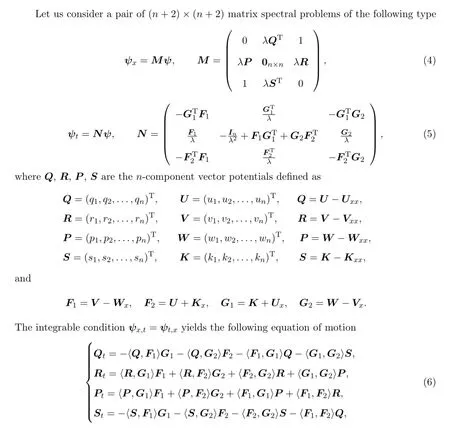


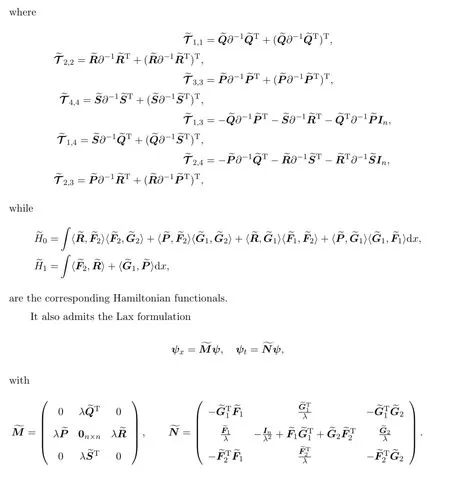
3 An infinite sequence of symmetries

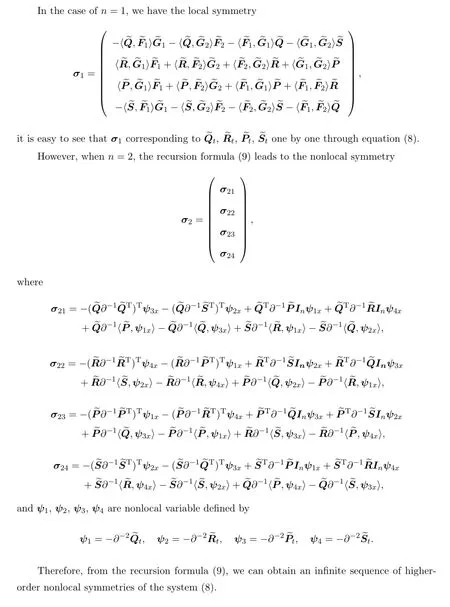
4 Reductions


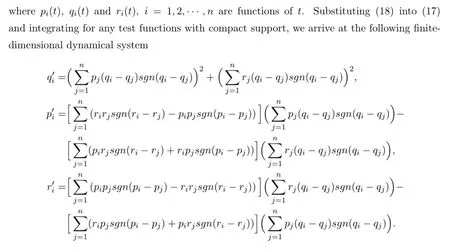
Reference
[1]Hunter J K,Saxton R.Dynamics of director fields[J].SIAM J.Appl.Math.,1991,51:1498-1521.
[2]Camassa R,Holm D D.A completely integrable dispersive shallow water equation with peaked solitons[J]. Phys.Rev.Lett.,1993,71:1661-1664.
[3]Fuchssteiner B,Fokas A S.Symplectic structures,their Bäcklund transformations and hereditary symmetries[J].Phys.D,1981/1982,4:47-66.
[4]Hunter J K,Zheng Y.On a completely integrable nonlinear hyperbolic variational equation[J].Phys.D,1994,79:361-386.
[5]Wang J P.Symmetries of the Hunter-Saxton equation[J].Nonlinearity,2010,23:2009-2028.
[6]Tian K,Liu Q P.Conservation laws and Symmetries of Hunter-Saxton equation[J]:revisited,arXiv:1501.03666v1[nlin.Si],2015.
[7]Schäfer T,Wayne C E.Propagation of ultra-short optical pulses in cubic nonlinear media[J].Phys.D,2004,196:90-105.
[8]Olver P J,Rosenau P.Tri-Hamiltonian duality between solitons and solitary-wave solutions having compact support[J].Phys.Rev.E,1996,53:1900-1906.
[9]Gui G L,Liu Y,Olver P J et al.Wave-breaking and peakons for a modified Camassa-Holm equation[J]. Comm.Math.Phys.,2013,319:731-759.
[10]Beals R,Sattinger D H,Szmigielski J.Inverse scattering solutions of the Hunter-Saxton equation[J]. Applicable Analysis,2001,78:255-269.
[11]Bressan A,Constantin A.Global solutions of the Hunter-Saxton equation[J].SIAM J.Math.Anal.,2005,37:996-1026.
[12]Novikov V.Generalizations of the Camassa-Holm equation[J].J.Phys.A,2009,42:342002,14pp.
[13]Hone A N W,Wang J P.Integrable peakon equations with cubic nonlinearity[J].J.Phys.A,2008,41:372002,10pp.
[14]Qu C Z,Song J F,Yao R X.Multi-component integrable systems and invariant curve flows in certain geometries[J].SIGMA,2013,9:001.
[15]Geng X G,Xue B.An extension of integrable peakon equations with cubic nonlinearity[J].Nonlinearity,2009,22:1847-1856.
[16]Li N H,Liu Q P,Popowicz Z.A four-component Camassa-Holm type hierarchy[J].J.Geom.Phys.,2014,85:29-39.
[17]Chen M,Liu S Q,Zhang Y J.A two-component generalization of the Camassa-Holm equation and its solitons[J].Lett.Math.Phys.2006,75:1-15.
[18]Xia B Q,Qiao Z J.Integrable multi-component Camassa-Holm system[J],arXiv:1310.0268v1,2015.
[19]Song J F,Qu C Z,Qiao Z J.A new integrable two-component system with cubic nonlinearity[J].J.Math. Phys.,2011,52:013503.
[20]Constantin A,Ivanov R I.On an integrable two-component Camassa-Holm shallow water system[J].Phys. Lett.A,2008,372:7129-7132.
[21]Gui G L,Liu Y.On the Cauchy problem for the two-component Camassa-Holm system[J].Math.Z,2011,268:45-66.
[22]Li N H,Liu Q P.On bi-Hamiltonian structure of two-component Novikov equation[J].Phys.Lett.A,2013,377:257-261.
[23]Li H M,Li Y Q,Chen Y.Bi-Hamiltonian structure of multi-component Novikov equation[J].J.Nonlinear Math.Phys.,2014,21:509-520.
[24]Popowicz Z.A four component cubic peakon(4CH)equations[J],arXiv:1511.00808v1[nlin.Si],2015.
[25]Olver P J.Applications of Lie Groups to Differential Equations[M].New York:Spring-Verlag,1998.
多分量退化的CH型方程的可积性及其解
甄肖燕
(宁波大学数学系,浙江,宁波315211)
主要研究多分量退化的含有立方项的CH型方程,并证明了其可积性:Lax表示,双哈密顿结构,以及递推算子.特别地,得到了一个退化的两分量的Novikov方程,并给出了其有限个拐点的奇性解.
双哈密顿结构,多分量CH型方程,极限约束,奇性解
O175.2
2016-01-10.
国家自然科学基金(11471174).
甄肖燕(1990-),硕士生,研究方向:非线性偏微分方程的研究.
10.3969/j.issn.1008-5513.2016.02.008
2010 MSC:35A01Document Code:AArticle ID:1008-5513(2016)02-0169-13

